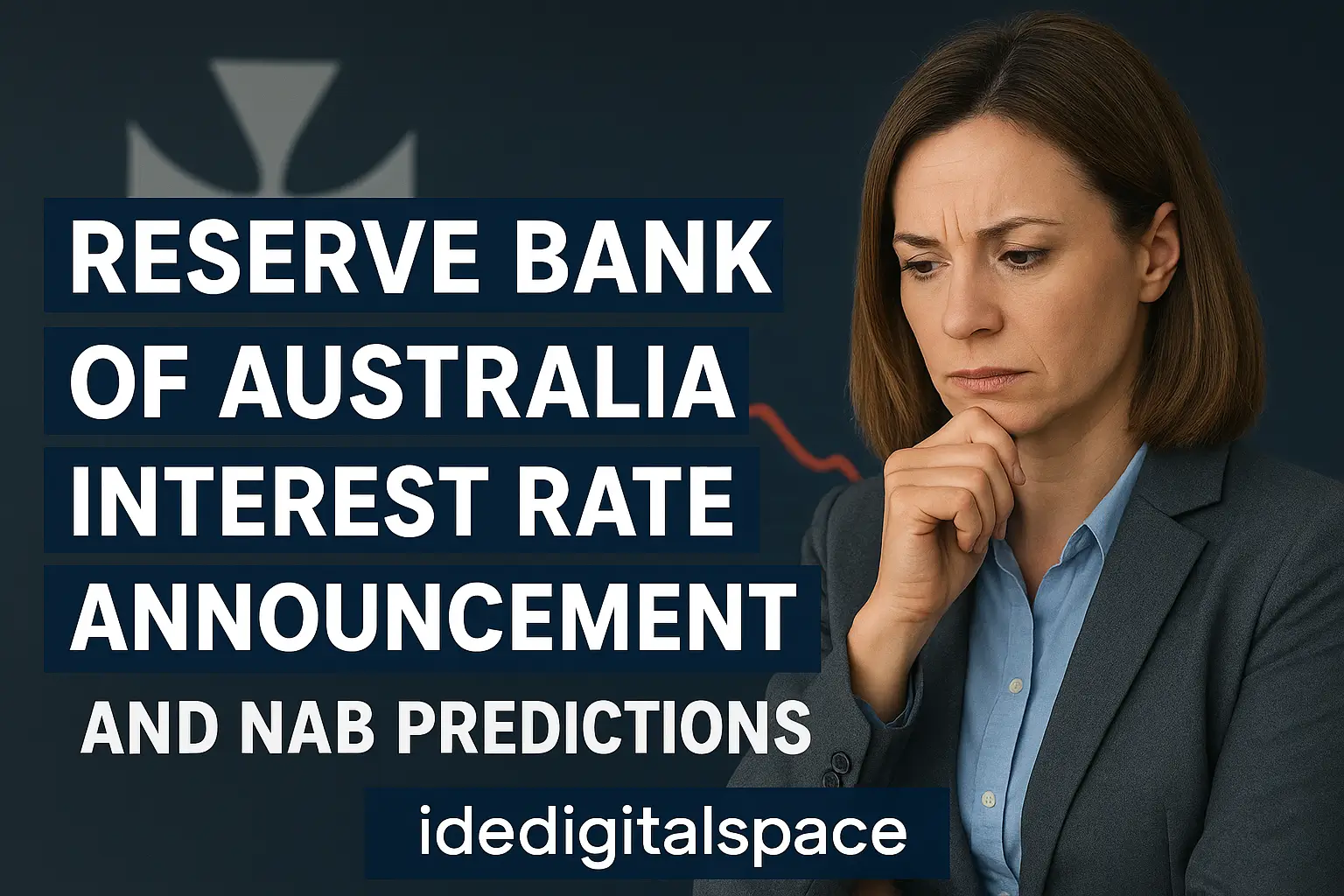Introduction: A Defining Monetary Moment
On September 30, 2025, the Reserve Bank of Australia (RBA) made headlines by choosing to hold the official cash rate steady at 3.60%, following three rate cuts earlier in the year. This move marks a critical turning point in the RBA’s monetary policy cycle, signaling a more measured and watchful approach after months of easing.
The decision reflects the central bank’s balancing act between controlling inflation, maintaining economic growth, and managing the financial stress faced by Australian households. With global economic uncertainties, a volatile housing market, and mixed signals from inflation data, the RBA interest rate announcement carries major implications for borrowers, investors, and policymakers.
In this blog, we unpack the latest RBA announcement, examine National Australia Bank (NAB)’s revised predictions, and analyze how these developments could shape Australia’s economic outlook through 2026.
1. RBA Interest Rate Announcement: A Strategic Pause in Policy
The RBA’s decision to hold rates at 3.60% signifies a strategic pause — not an endpoint — in its monetary easing cycle. After implementing three cuts earlier in 2025 to stimulate post-pandemic growth and counter sluggish global trade, Governor Michele Bullock emphasized that the current level strikes a delicate equilibrium between supporting demand and containing price pressures.
In her post-meeting statement, Bullock reiterated that while inflation is gradually aligning with the RBA’s 2–3% target range, risks remain. Domestically, household consumption continues to recover, yet external factors like global oil price volatility, China’s economic slowdown, and geopolitical tensions could trigger renewed inflationary pressures.
The RBA’s stance highlights its data-driven decision-making, prioritizing long-term stability over short-term stimulus. Economists note that by maintaining the rate, the RBA is giving past cuts time to filter through the economy — avoiding premature moves that might reignite inflation.
In essence, the RBA interest rate announcement confirms that the bank is entering a “wait-and-watch” phase, evaluating whether the current monetary settings are sufficient to sustain moderate growth without overstimulating demand.
2. Economic Indicators Shaping the RBA’s Decision
Behind the RBA’s cautious stance lies a detailed assessment of Australia’s economic fundamentals. Several key indicators have guided policymakers in maintaining the current cash rate:
a) Inflation Trends
Australia’s core inflation currently hovers around 2.6%, a figure consistent with the RBA’s target range. However, headline inflation — influenced by energy costs and supply chain pressures — is expected to edge up to 3.1% by mid-2026.
While the slowdown from last year’s peak is encouraging, services inflation and housing rents remain sticky, suggesting that price pressures haven’t fully dissipated.
(Source: Reuters)
b) Unemployment and Labor Market Strength
The unemployment rate at 4.2% underscores the resilience of Australia’s labor market. Job creation has remained robust, driven by healthcare, construction, and technology sectors.
However, wage growth — now averaging 3.4% year-on-year — could add upward pressure to inflation if productivity gains don’t keep pace.
c) GDP and Consumer Spending
Australia’s GDP growth slightly exceeded expectations in the June quarter, supported by a rebound in household consumption and public investment. The recovery in tourism and education exports has also provided momentum.
Yet, economists caution that rising living costs and mortgage burdens may constrain spending in the second half of 2025.
(Source: ABC News)
Collectively, these indicators paint a picture of an economy in transition — stable but still vulnerable to inflationary flare-ups and external shocks. Hence, the RBA’s decision to hold rates can be viewed as a prudent attempt to balance growth with inflation discipline.
3. NAB’s Revised Forecast: Stability Over Aggressive Easing
Following the latest RBA interest rate announcement, National Australia Bank (NAB) updated its monetary policy outlook. Previously, NAB had projected further rate cuts in November 2025 and February 2026. However, based on stronger-than-expected inflation readings in service sectors, NAB economists now believe the RBA will maintain the cash rate at 3.60% until at least May 2026.
This shift in forecast reflects the growing consensus that the RBA will adopt a longer holding pattern — waiting for clear, sustained evidence that inflation is firmly anchored before cutting again.
According to NAB’s chief economist, the revised projection acknowledges that market-based inflation expectations remain elevated. Additionally, household debt levels and property market imbalances call for a careful approach to prevent overheating.
(Source: news.nab.com.au)
In essence, NAB’s outlook aligns with the RBA’s broader message: policy normalization must be gradual and evidence-based, rather than driven by market pressure or political expectations.
4. Implications for Borrowers and the Housing Market
For millions of Australian borrowers, the RBA’s decision to hold rates steady provides a moment of relief. After months of fluctuations, mortgage holders can now plan with a greater degree of certainty.
However, stability doesn’t mean comfort. Average variable mortgage rates remain above 6%, keeping pressure on household budgets. Financial advisors recommend that borrowers continue building repayment buffers and avoid over-leveraging, especially amid lingering inflation risks.
In the housing sector, the impact of rate stability is twofold:
- Short-Term Relief: A steady rate environment can stabilize demand and support moderate price growth.
- Structural Challenges: Australia’s housing supply shortage — with building approvals near decade lows — continues to push prices higher, particularly in Sydney and Melbourne.
Economists warn that without significant supply-side reforms, affordability could worsen, even if interest rates remain unchanged. Developers cite labor shortages and regulatory delays as key barriers to new construction.
(Source: The Australian)
Therefore, while the RBA interest rate announcement brings short-term calm, the structural dynamics of the housing market demand policy interventions beyond monetary tools.
5. Market Reactions: Investor Sentiment and Currency Movements
Financial markets responded swiftly to the RBA’s latest move. The ASX 200 index fell 14 points (0.16%), closing at 8,848.80, as investors digested the implications of a prolonged rate plateau. This minor decline broke a five-month winning streak, signaling cautious optimism rather than panic.
Meanwhile, the Australian dollar (AUD) strengthened by 0.35% to US$0.6602, buoyed by investor confidence in Australia’s macroeconomic resilience. Currency analysts noted that the RBA’s restraint enhances credibility among global investors, making the AUD relatively attractive amid a turbulent global currency market.
(Source: News.com.au)
Bond markets also stabilized following the announcement, with 10-year yields holding near 3.9%, suggesting expectations of policy stability through early 2026. Overall, market participants seem aligned with the RBA’s narrative — patience now for sustainability later.
6. Broader Economic Outlook: What Lies Ahead
As 2025 draws to a close, attention now turns to November’s quarterly inflation report, which will serve as a key guidepost for the RBA’s next steps. Analysts expect inflation to remain slightly above target through early 2026 before easing closer to 2.5% by year-end.
Several factors will influence the RBA’s policy trajectory:
- Global headwinds, including U.S. interest rate shifts and China’s property slowdown.
- Domestic fiscal policy, especially government spending on infrastructure and energy transition.
- Consumer confidence, which remains fragile despite stable employment.
The RBA has reiterated that future decisions will be data-driven, with no predetermined path. Governor Bullock emphasized that flexibility is essential in a complex environment shaped by geopolitical uncertainty and rapid technological change.
For businesses and households alike, this means adaptability will be key. Whether planning investments, managing debts, or adjusting savings strategies, staying informed about the RBA interest rate announcements is vital.
7. Key Takeaways: Understanding the RBA’s Balancing Act
The RBA’s pause at 3.60% is neither dovish nor hawkish — it’s a measured midpoint. It acknowledges progress in taming inflation but recognizes the fragility of global recovery.
From NAB’s revised outlook to steady employment figures, the message is consistent: Australia’s economy is stable but not immune to shocks.
For borrowers, this is a window to reassess financial priorities; for investors, a reminder that discipline and diversification remain crucial.
Conclusion: A Cautious Confidence in Australia’s Future
The Reserve Bank of Australia’s interest rate announcement is more than a technical policy update — it’s a statement of confidence in the country’s economic direction. By holding the cash rate steady at 3.60%, the RBA signals belief in the strength of Australia’s recovery while acknowledging the need for prudence.
NAB’s updated forecast underscores this sentiment, anticipating a longer stretch of rate stability before the next policy shift. For everyday Australians, the message is clear: the worst of volatility may be behind us, but vigilance is essential.
As global conditions evolve, one thing remains constant — the RBA’s commitment to sustainable growth, stable inflation, and long-term prosperity.
Related Posts
- Imperial Oil Layoffs Calgary Latest CBC News Update
- Pushkar tourist places
- Bikaner tourist places
- Jaisalmer tourist places
- Jodhpur tourist places

mohit Meena is a travel blogger and founder of freeindia.online, passionate about exploring hidden gems and sharing travel tips to help others plan memorable trips across India.





